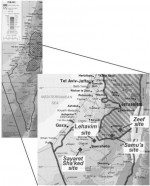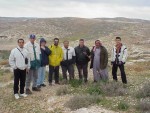Two capable forces in ecological cooperation and networking are joining together.
"We would like to merge the concepts of the CMC and ILTER," said John Olson, Northeast Asia program manager for the Cooperative Monitoring Center (CMC)
On 6 April 1999, several members of the CMC met with Chris French, John Vande Castle and Jim Gosz to discuss possibilities of collaborating on projects in Asia and the Middle East.
The Cooperative Monitoring Center is funded by the Department of Energy and located at Sandia National Laboratory in Albuquerque, NM. The CMC’s mission is to assist political and technical experts from around the world acquire the technology-based tools they need to analyze, design, and implement nonproliferation, arms control, and other security measures-including those involving environmental and natural resources.
The CMC is attempting to develop a cooperative project with North Korea involving sustainable development in the Tumen River basin between North Korea, China, and Russia. "Contacts are difficult to make in that part of the world," Olsen said. "Our goal is to enhance regional stability using technology and communication and a project to involve both of the Koreas," Olsen said. "We would like to supplement military-based projects with environmental projects."
There is an active ILTER Network in the East Asia-Pacific Region, but crossing difficult political boundaries remains a challenge. A visit by Olsen or another CMC staff member "could provide the CMC with an opportunity to establish useful scientific and political contacts on both sides of the Demilitarized Zone," (DMZ) says Eun-Shik Kim, coordinater of the Korean LTER Network. A CMC-sponsored project could also facilitate contacts and cooperation between scientists in the divided country, and help ILTER scientists to pursue opportunities for environmental research in the DMZ—an area that is currently inaccessible.
The Middle East Sustainable Land Use Initiative
The CMC has assembled a team of scientists in support of the Middle East Sustainable Land Use Initiative.This project encourages joint participation between Palestinian and Israeli scientists in ecological observation and research.
A visit to sites in Israel and the West Bank 20 February through 3 March of 1999 involved a team comprised of CMC representatives Tim Crawford and David Betsill; Palestinians Hazem Qawasmeh, Shawqi Sa’adeh, and Younis Sbieh of the Ministry of Environmental Affairs (MENA), and Akrum Tamimi and Ayed Mohommed of Hebron University, and Israelis Moshe Shackak, Eli Zaady, and Bert Boeken of Ben-Gurion University, and Avi Perevolosky, Volcani Institute of the Ministry of Agriculture.
The plan is to install "Tier II" meteorological stations at two sites in Israel and two sites on the West Bank. ILTER will provide the conceptual and organizational umbrella. CMC will procure, import, and install meteorological data collection, provide one year of cellular phone service for remote data transmission, and will perform network integration for communication and data sharing (including a Web site). Hebron and Ben-Gurion Universities and MENA will provide sites and all existing data, site maintenance and security, as well as research, administrative and technical staff.
Physical security of the stations and access to the sites is a concern. Crossings between Israel and the West Bank are closely monitored by Israeli security forces. The Zeef site (see map) is in an area of Palestinian civil authority and Israeli military control. The Samou’a site is in an area of Israeli civil and military control. The Lehavim and Sayaret Sha’ked sites are both LTER sites, and are controlled by Israel.
Data access is another concern. "We must establish trust between the scientists," Betsill said. Raw data will be used at first, with no interpretation. "They need to see for themselves what is produced by these met stations. Then perhaps in the future we can develop metadata."
Gosz and Vande Castle offered input regarding use of LTER standards for climate data.
The field trip included a precedent-setting joint visit to each participant’s research site. "The scientists had never visited each other’s sites," Betsill said. "We were able to establish a good rapport, and stimulate discussion about other possible collaborations."
Please see article in the Fall 1998 issue of the LTER Network Newsletter about the first stage of CMC/ILTER cooperation:
For more information about the CMC, visit the Web site: http://cmc.sandia.gov/
For more information about the Israeli LTER program, see the ILTER Web site: http://www.ilternet.edu

 Enlarge this image
Enlarge this image
